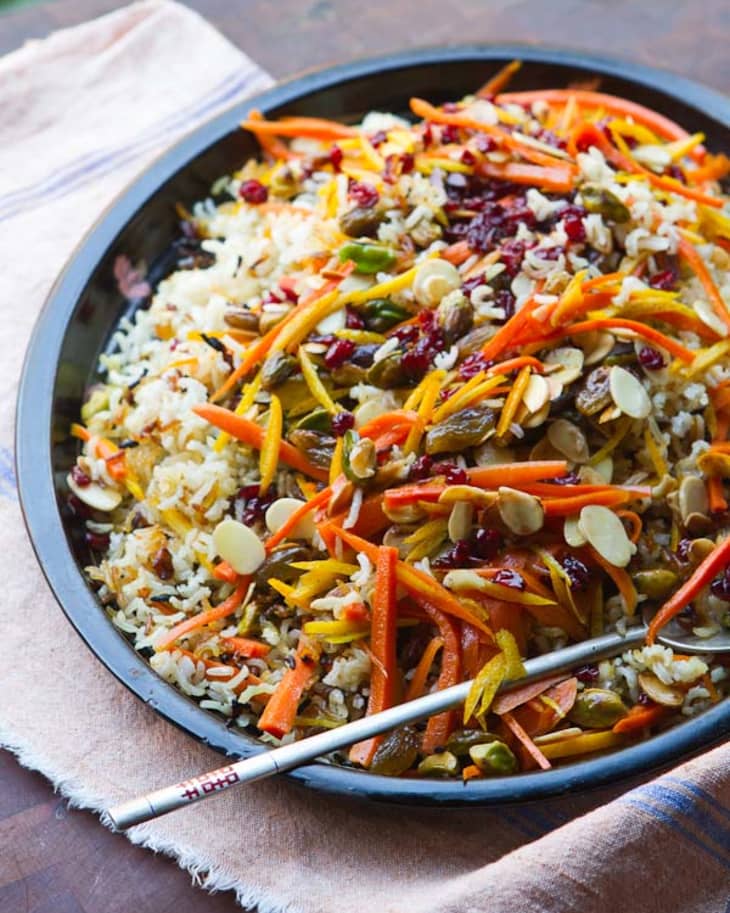Iranian Jeweled Rice

I recently spent a few days with Najmieh Batmanglij — known to many as the “Queen of Persian Cooking” — who opened me up to the cooking of her native Iran, and in particular to a rice dish called jeweled rice, or Javaher Polow.
When I took my first bite, I almost cried from a near overload in flavor, fragrance, balance and a notable infusion of love in the grains of rice, tart little barberries, and strands of candied orange peel.
Ingredients That Make Up Jeweled Rice
Named for its gemstone colors — saffron, carrots and orange peel make gold, barberries make rubies, pistachios
Rice is a central and ancient staple of the modern Iranian kitchen, though the varieties traditionally cultivated in Iran are not easy to come by in the West. Here, we can come close using basmati, or in a pinch, other varieties of long-grain rice. What’s beautiful about basmati is how it fills the home with the scent of flowers as it cooks.
Barberries are a tiny red berry once used in a lot of European cooking but now only found in Iranian cuisine. You can order them online from Sadaf, find them in some Middle-Eastern groceries (I go to
Kalustyan’s
A Dish For Any Celebration
This version is adapted from Najmieh, cutting out some of the oil and sugar in her version for a lighter take on what’s usually a decadent dish, both in its ingredients and in the time it takes to prepare it. It is not a dish you should expect to bang out after work and have dinner on the table at a reasonable hour, unless you can prep out your ingredients ahead of time like I did below.
Instead, for your first go, make it a celebration. Take your time, source the best ingredients, treat each step of this recipe like a precious stone.
→ Check out Najmieh Batmanglij’s books on Amazon!
Iranian Jeweled Rice
Serves 8
Nutritional Info
Ingredients
- 3 cups
long-grain white basmati rice
- 2 tablespoons
salt, divided
- 2
large oranges, preferably organic
- 1 cup
whole dried barberries or chopped unsweetened dried cranberries
- 1 teaspoon
loosely-packed saffron (about 1/2 gram) or 1/2 teaspoon ground tumeric
- 1/3 cup
granulated sugar, divided
- 1/4 cup
orange blossom water, divided
- 2 tablespoons
oil, butter or ghee
- 1/2 cup
sliced raw almonds, toasted
- 1/2 cup
chopped raw pistachios, toasted
- 1/2 cup
golden or green raisins
- 2-3
large carrots, peeled and cut into 2-inch long matchsticks
One 4-inch whole cinnamon stick
- 2 teaspoons
freshly ground cardamom
Instructions
Wash the rice in a large container of water, swishing it around with your hand then draining off the water and repeating until the water runs clear, about five times. Cover again with water, add 2 tablespoons of the salt and soak between 2 and 24 hours. Drain through a fine-mesh sieve and set aside.
Set a small pot of water to boil. Use a vegetable peeler to take thick strips of rind off the oranges, including a little of the white pith. Slice these strips cross-wise into very small slivers. When the water is boiling, drop the slivers into the water and cook 1 minute. Drain and rinse with cold water. Set aside. (This cuts the bitterness of the orange rind.)
Clean the barberries by removing any stems or debris. Place them in a sieve set inside a bowl. Cover with cold water and soak for 20 minutes. Pull the sieve from the bowl and rinse under cold water to flush out any remaining sand. Set aside. (If using cranberries, skip this step.)
In a mortar and pestle, crush the saffron threads with a few pinches of sugar until a powder forms. Stir in 3 tablespoons of orange blossom water and set aside.
Heat 1 tablespoon oil in a large skillet (12-inches or more) over medium heat. Add the almonds and the pistachios, and sauté for about a minute. Add the raisins to the pan and toss with the nuts. Empty the mixture into a bowl and set aside.
Heat 2 tablespoons of the saffron orange blossom water mixture, 1 tablespoon of sugar and 1 tablespoon oil over medium heat in the same skillet. Add the carrots and orange peel and sauté for 2 minutes. Add the remaining sugar, the remaining saffron orange blossom water mixture, the cinnamon stick and the cardamom and sauté for 1 minute. Add 1 cup water, bring to a boil over high heat, then lower to medium heat and cook for about 10 minutes, or until the carrots lightly caramelize and the liquid has reduced to a syrup. Drain the carrots and orange peel, and reserve the syrup.
In a large heavy-bottomed pot with a lid, bring ten cups of water to a boil. Add the remaining 2 tablespoons salt, and then add the rice to the pot with the remaining 1 tablespoon plain orange blossom water. Boil briskly until the rice has risen to the surface and when bitten into, a grain of rice feels soft, 6 to 10 minutes. Drain the rice into a large fine-mesh sieve, rinse with cold water and turn it out into a bowl.
Gently mix the remaining saffron orange blossom water and the reserved carrot/orange syrup to the par-boiled rice. Take a large spoonful of rice at a time and gently spread it over the bottom of the pot. Give the pot a shake to even out the base. Add more spoonfuls of rice, one at a time, gradually shaping it into a pyramid. (This shape leaves room for the rice to expand and enlarge.)
Wrap the lid of the pot with a clean dish towel and cover firmly to prevent steam from escaping. Cook 20 minutes over low heat.
To serve, arrange on a serving platter layers of rice, then the caramelized carrot mixture (discarding the cinnamon stick), then the barberry/nut mixture.
